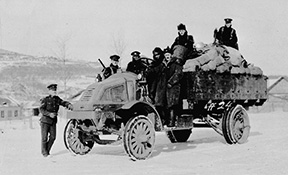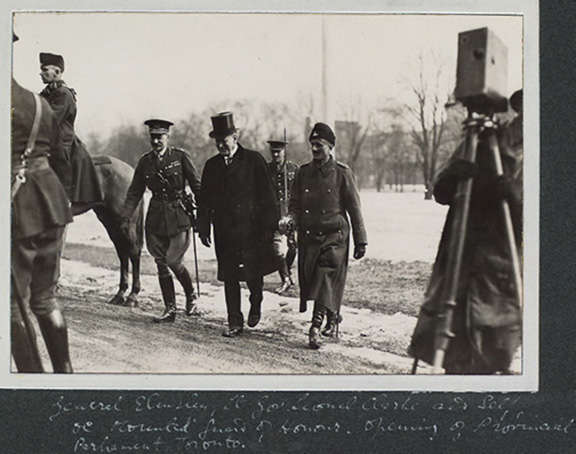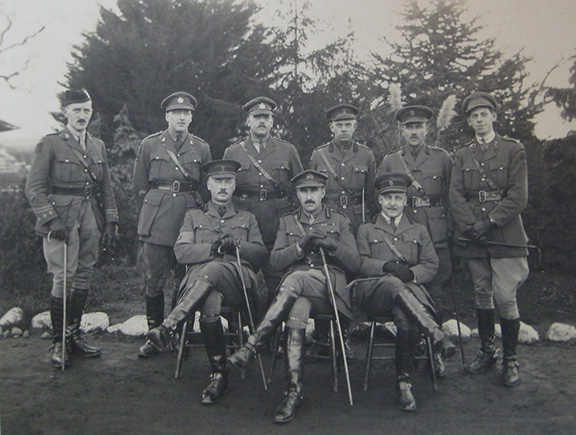Siberia
First World War
Date
No date parameters defined.

Personnel of the Canadian Siberian Expeditionary Force with truck. ca. January. - May 1919. Vladivostok, Russia
Credit: Raymond Gibson / Library and Archives Canada / C-091749; (MIKAN no. 3194493)
Geographical parameters
No geographical parameters defined.
Context
A theatre of war honour formally entitled “Siberia” with year dates according to the service in each theatre of the unit concernedFootnote 1.
Description
In 1917 the Russian government was overthrown by Bolshevik (Communist) forces which had then concluded a peace treaty with the Germans, the Treaty of Brest-Litovsk. The Allied forces were concerned about the Germans gaining Russia's wheat, oil and minerals, which would have had the effect of negating the Allied blockade of Germany. Consideration was given to intervening in Russia but the Allies remained divided among themselves about this possibility. The catalyst for action was an armed Czech force then in western Russia that had been attached to the Russian Army. The Germans wanted the Czechs disarmed. When the Bolsheviks attempted to do this, the Czechs responded by seizing the trans-Siberian railway and making their way east toward Vladivostok hoping to circumnavigate the world and arrive on the Western Front. The American President announced the creation of an international force to land in Siberia in order to “restore and preserve the communications of the Czechs.” The force would include American, British and Japanese elements. The Canadian Prime Minister, Sir Robert Borden, was in London at the time of this decision and decided that it would be advantageous for Canada to be involved in this operation. Subsequently the Canadian Expeditionary Force (Siberia) (Major-General J.H. Elmsley) was raised which included the 16th Infantry Brigade Headquarters (Brigadier-General H.L. Bickford), two infantry battalions, the 259th and 260th, B Squadron of the Royal North West Mounted Police as the brigade cavalry squadron, plus other units. The force of roughly 3,800 all ranks sailed to Siberia in October 1918 and returned to Canada in June 1919 without being operationally engaged. The Theatre Honour awarded was Siberia, 1918-19.

Item is a photograph of "A" Company, 260th Battalion, Canadian Siberian Expeditionary Force, Major D.S. Bauld, Commanding Officer. Saint John, N.B.
Credit: Photo by the Reid Studio. 1918, The National Archives of Canada. (MIKAN no. 161007)

From left to right, General James Elmsley, Lieutenant-Governor Lionel Clarke and Reginald S.Timmis attending the opening of Provincial Parliament, Toronto, Ont. 1920.
Credit: Timmis, Reginald Symonds, 1884-1968; Baldwin Collection; Toronto Reference Library/ 995-1-10-13a

Officers of the 16th Infantry Brigade Headquarters,CEF (Siberia), Willows Camp.(Front, L-R): Lieutenant-Colonel H.C.Sparling, Brigadier-General H.C.Bickford, Major J.W.Sifton. (Rear, L-R): Captains S.D.Dougall, J.R.McIlree, L.F.Scholes, C.T.Clark, W.F. Howland, E.J. Thom. Victoria, British-Columbia. December, 1918. Credit: Library and Archives Canada/PA-164371 (MIKAN no. 3227420)
Awarded to:
Currently Serving Units
1918-19
- 12e Régiment blindé du Canada
Award to the 259th Battalion (Canadian Rifles), CEF (1918-19) (GO 123/29) - Princess Patricia's Canadian Light Infantry
Award to the 260th Battalion (Canadian Rifles), CEF (1918-19) (GO 123/29)
Page details
- Date modified: